Types of Traps
Trap efficiency is important, so keep in mind that catch size is a limiting factor with certain types of traps. Factors to consider when selecting the type of pig trap that will best meet your needs are
- sounder size
- affordability
- weight and portability
- presence and numbers of nontarget species such as deer or black bear
HIGH-TECH TRAPS
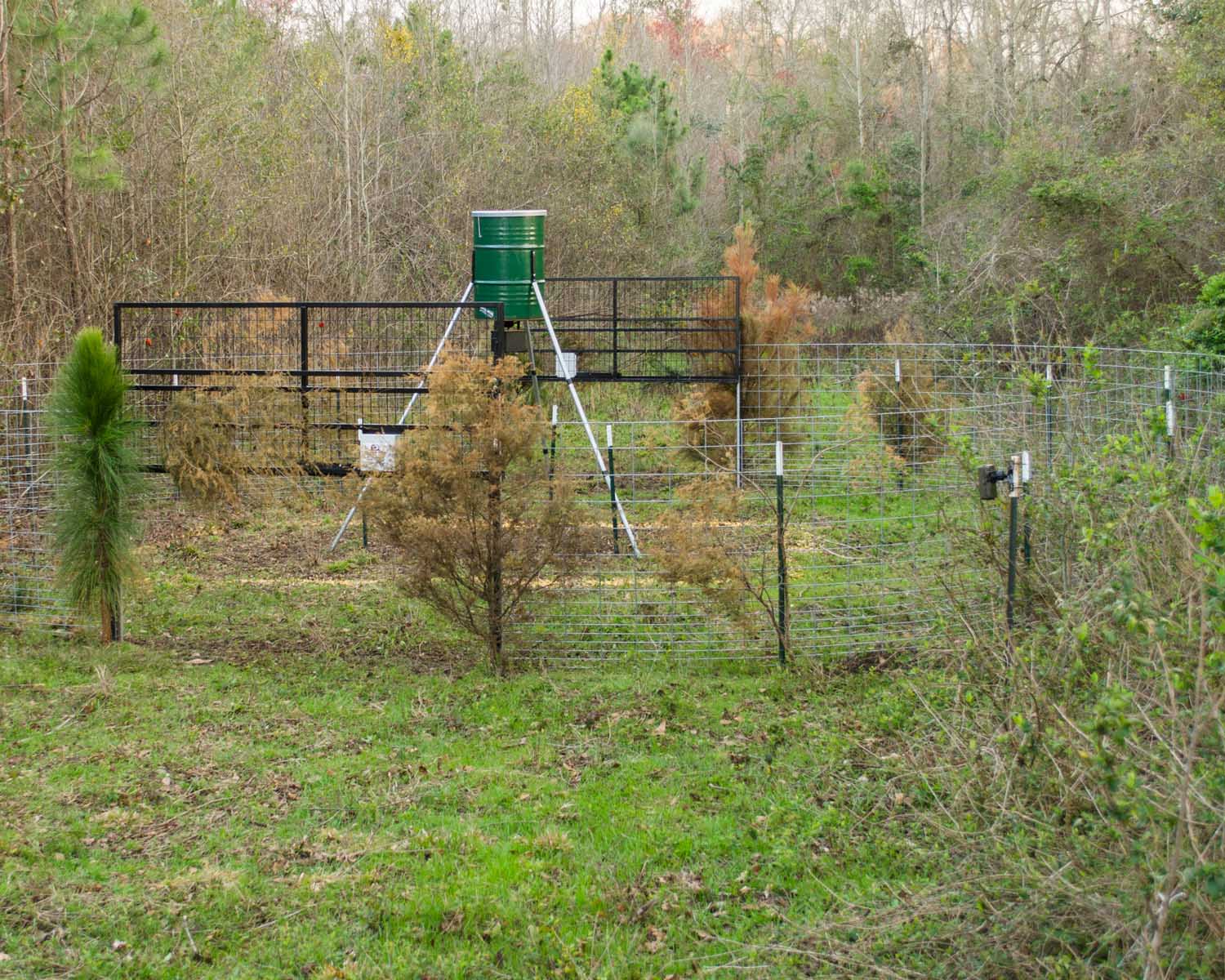 Double Gate Camo
Double Gate Camo
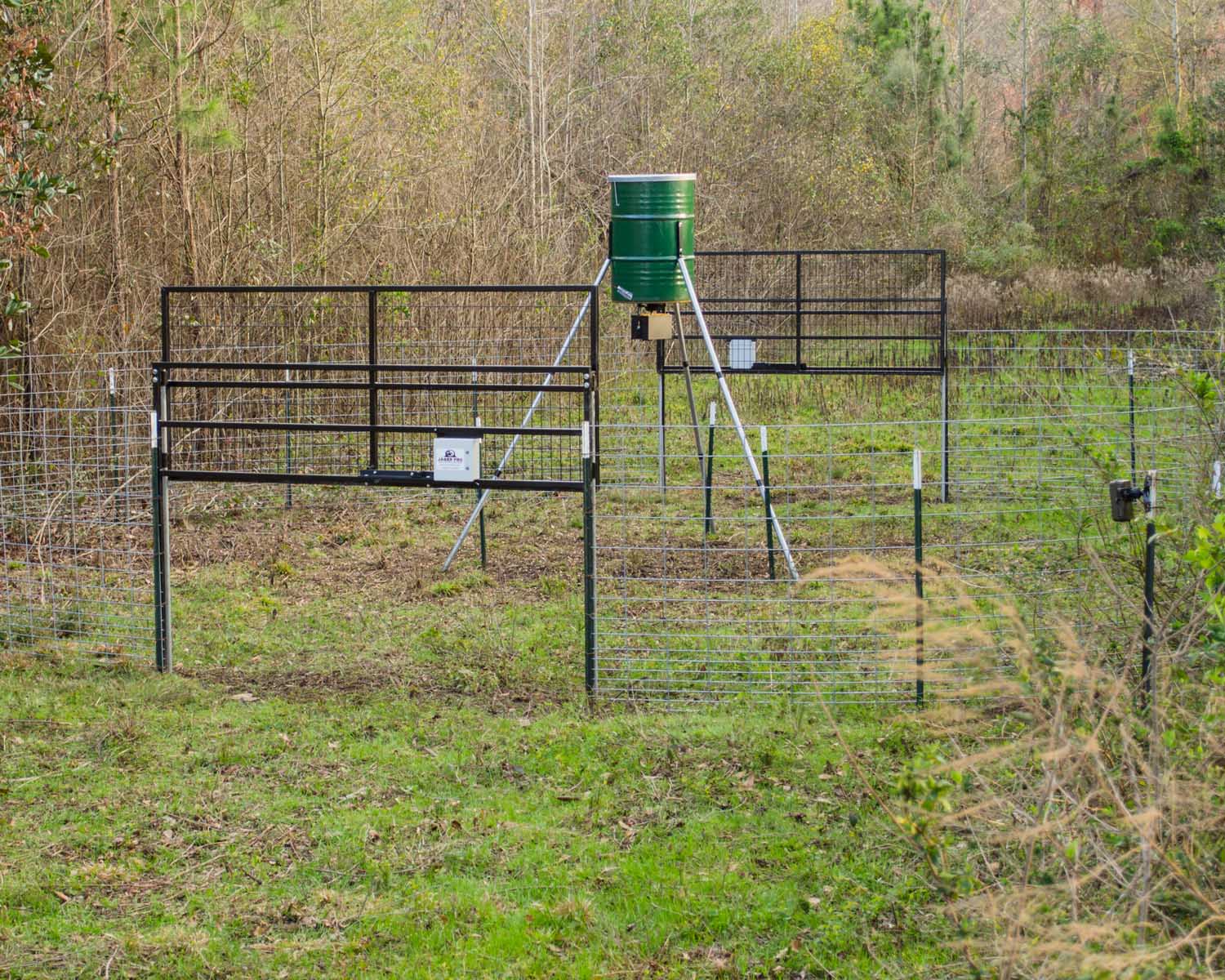 Double Gate No Camo
Double Gate No Camo
BOX TRAPS
Pros of Using a Box Trap
Box traps are simple to construct and less expensive than commercial traps made of steel. Also, because they are collapsible they require less space for transport and storage.
Cons of Using a Box Trap
Catch size per trapping effort is limited to a small number of pigs. The wooden panels of the box trap present a more confining appearance than wire panel traps, and they require more long-term maintenance. Also, the 8-foot side panels are heavy and can be difficult for one person to handle alone.
Materials
Box traps are rectangular or square structures made of wood fence panels constructed from 2-by-4-inch and 1-by-4-inch or 1-by-6-inch boards.
Design
The most common box trap design is 4 feet wide, 8 feet long, and 5 feet high with no fixed top or bottom. (A top is not necessary because the 5-foot-high side panels prevent pigs from climbing out). Jump bars or corner covers can be installed to prevent captured pigs from climbing out of box traps. However, do not cover a trap's top entirely. See link on nontarget species.
Trap Doors
The trap is usually equipped with a single-catch wooden drop door, but it also can be equipped with a trap door, such as the saloon-style door. Box traps are heavy enough that pigs usually are unable to root under the sides and use their head to lift the trap and escape. However, it is still best to secure box traps by driving a steel T-post into the ground opposite corners of the front and back and fastening the trap sides to the T-posts with wire.
The box trap can be transported in panels and assembled on location using 3-inch exterior decking screws (nails are not recommended). A trip wire or root stick is the best trigger mechanism to use with box traps.
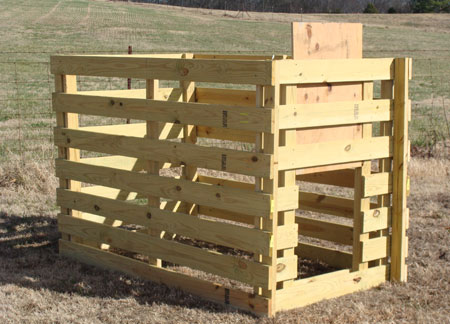
CAGE TRAPS
Pros of Using a Cage Trap
Cage traps may have an advantage over wooden box traps because the wire panel
construction is thought to present a more open and less confining appearance
to wild
pigs. Also, the trap designs usually allow for easy one-person transport and
setup.
Cons of Using a Cage Trap
Catch size per trapping effort is limited to a small numbers of pigs. Traps with overhead panels are reason for concern because they can prevent the escape or release of nontarget species such as deer and black bear.
Materials
Cage traps are constructed from heavy-gauge wire livestock panels welded to a steel angle iron or square tubing frame.
Designs
The most common cage trap design is a rectangular enclosure ranging in size from 4 feet high, 6 feet long, and 4 feet wide to 5 feet high, 12 feet long, and 4 feet wide.
A more recent design is a circular cage trap with wire livestock panels welded to a round steel frame (similar to livestock hay rings). The advantage of this design is its portability; it can be rolled onto a trailer or rolled along the ground.
Another design is similar to the box trap and is made up of wire livestock panels welded to individual steel frames and fastened together with pins or bolts.
Panels and Doors
Commercially available cage traps often have both a top (overhead) and bottom (floor) panel and are equipped with a spring-loaded, single-catch or multicatch trap door at one end of the cage.
Cage traps less than 5 feet tall should include a top panel to prevent pigs from escaping over the sides. Bottom or floor panels are not necessary for well-built cage traps. In fact, many experienced pig trappers recommend not using floor panels. Their reasoning is that most pigs do not like the feel of the wire panel underfoot and will balk at fully entering the trap.
To prevent large pigs caught in this type of trap from lifting the trap and escaping underneath the side panels, wire the trap to T-posts driven into the ground at opposite front and back corners.
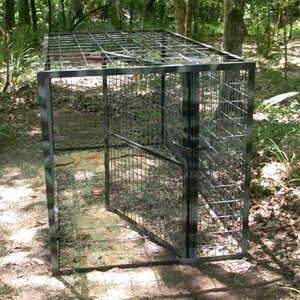 Cage Trap for Wild Pigs
Cage Trap for Wild Pigs
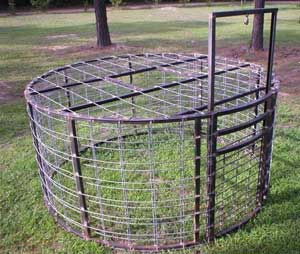 Round Cage Trap for Wild Boar
Round Cage Trap for Wild Boar
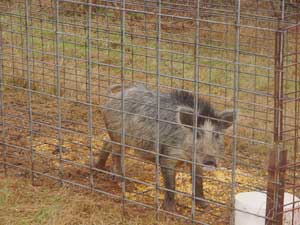 Wild Pig in a Cage Trap
Wild Pig in a Cage Trap
CORRAL TRAPS
Pros of Using a Corral Trap
Corral size can be easily adjusted by adding or taking away livestock panels,
allowing the trap to be enlarged for larger sounders. The open top allows
for the
escape of nontarget species, and the trap’s larger size combined with the
open
appearance of the livestock panels may appear less threatening to trap-shy
pigs.
Cons of Using a Corral Trap
Corral traps require more setup time than box and cage traps. The 16-foot livestock panels may need to be cut in half for transport, thus requiring more assembly time and effort, and tree roots in wooded habitats sometime pose a problem for driving and pulling T-posts. A T-post “puller” is a wise investment.
Corral traps are the most effective type of trap for catching large groups of pigs. Though corral traps can vary in shape, many experienced pig trappers recommend a circular trap because it prevents captured pigs from piling into corners and escaping over the top.
Materials
Corral traps can be constructed using heavy-gauge wire or U-bolts to fasten 16-foot by 5-foot welded wire livestock panels to 6½-foot steel T-posts. Corral traps require more setup time, but the potential capture rates are much higher. Three or four 16-foot by 5-foot panels will produce a trap of sufficient size for catching most sounder groups. You can easily expand the trap’s size by adding more livestock panels.
How To Build It
To build a circular corral trap, begin by overlapping the livestock panel ends 1 foot and securing the adjoining ends using nylon zip ties or cable ties. Be sure to leave two panel ends free to accommodate the trap door. (Either a single-catch or multicatch trap door can be used.) Next, shape the corral by pushing or pulling the joined panels in or out as you work them into a circle. Once the corral is fashioned to your liking, set the trap door in place and drive T-posts into the ground immediately next to and on each side of the trap door. Attach the loose panel ends securely to both the trap door frame and T-posts with heavy-gauge wire.
Trap Door
If using a trap door that does not extend to a height of 5 feet, you will need to account for the height difference to prevent pigs from jumping over the trap door. There are two ways to do this:
- If the trap door is positioned between the ends of two livestock panels as described above, use a piece of livestock panel or other heavy-duty mesh wire to cover the opening above the trap door.
- Simply cut an opening for the trap door in the middle of one of the 16-foot livestock panels. Be sure to install T-posts on each side of the trap door for additional support and use heavy-gauge wire to attach the door to the livestock panel and T-posts.
With the trap door securely in place, finish the trap by working your way around the corral and driving a T-post in the ground every 8 feet on the outside of the panels (at the overlapped ends and the middle of each panel). For additional reinforcement, include an extra T-post four feet on each side of the door (the brunt of escape efforts will be focused on either side of the door). Use heavy-gauge wire to fasten the livestock panels to the T-posts every 1 foot beginning at ground level (five per T-post). Another option is to use U-bolts as fasteners (two to three per T-post).
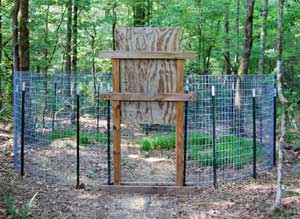 Corral Trap Outfitted with a Single-catch Wooden Drop
Door.
Corral Trap Outfitted with a Single-catch Wooden Drop
Door.
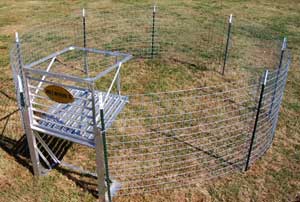 Corral Trap Outfitted with a Multi-catch Root Door.
Corral Trap Outfitted with a Multi-catch Root Door.
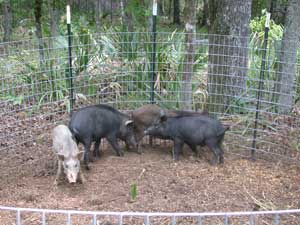 Wild Pigs Captured in a Corral Trap
Wild Pigs Captured in a Corral Trap
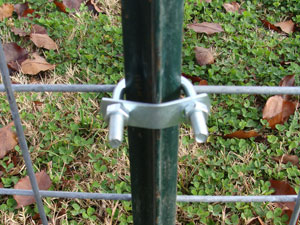 U-Bolt
U-Bolt
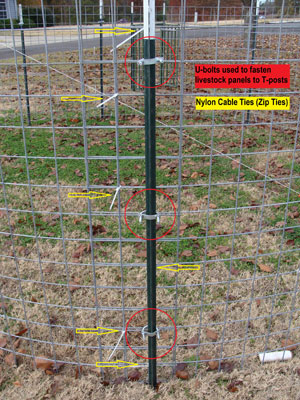 U-Bolt fastening a livestock panel to t-post
U-Bolt fastening a livestock panel to t-post
Livestock Panels
Livestock panels used in constructing wild pig traps should be of at least 4-gauge size and no less than 5 feet high. Though it is not impossible, only the rarest of pigs can jump a 5-foot-tall panel. A mesh size of 4 inches square or smaller will prevent small pigs from escaping through the panels.

